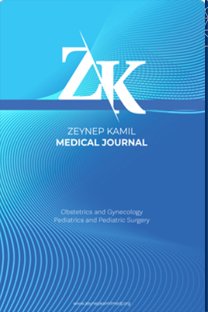Evaluation of the relationship between ocular surface symptoms and platelet-to-lymphocyte ratio in COVID-19 patients
Evaluation of the relationship between ocular surface symptoms and platelet-to-lymphocyte ratio in COVID-19 patients
___
- 1. Ahn DG, Shin HJ, Kim MH, Lee S, Kim HS, Myoung J, et al. Current status of epidemiology, diagnosis, therapeutics, and vaccines for novel Coronavirus disease 2019 (COVID-19). J Microbiol Biotechnol 2020;30(3):313–4.
- 2. Wang C, Horby PW, Hayden FG, Gao GF. A novel coronavirus outbreak of global health concern. Lancet 2020;395(10223):470–3.
- 3. Guo YR, Cao QD, Hong ZS, Tan YY, Chen SD, Jin HJ, et al. The origin, transmission and clinical therapies on Coronavirus disease 2019 (COVID-19) outbreak-an update on the status. Mil Med Res 2020;7(1):11.
- 4. Lu CW, Liu XF, Jia ZF. 2019-nCoV transmission through the ocular surface must not be ignored. Lancet 2020;395(10224):e39.
- 5. Seah IY, Anderson DE, Kang AE, Wang L, Rao P, Young BE, et al. Assessing viral shedding and ınfectivity of tears in Coronavirus disease 2019 (COVID-19) patients. Ophthalmology 2020;127(7):977–9.
- 6. Wu P, Duan F, Luo C, Liu Q, Qu X, Liang L, et al. Characteristics of ocular findings of patients with Coronavirus disease 2019 (COVID-19) in Hubei Province, China. JAMA Ophthalmol 2020;138(5):575–8.
- 7. Hong N, Yu W, Xia J, Shen Y, Yap M, Han W. Evaluation of ocular symptoms and tropism of SARS-CoV-2 in patients confirmed with COVID-19. Acta Ophthalmol 2020 26:10.1111/aos.14445. doi: 10.1111/aos.14445. [Epub ahead of print.]
- 8. Gambini G, Savastano MC, Savastano A, de Vico U, Crincoli E, Cozzupoli GM, et al. Ocular surface ımpairment after Coronavirus disease 2019: a cohort study. Cornea 2021;40(4):477–83.
- 9. Chan AS, Rout A. Use of neutrophil-to-lymphocyte and platelet-to-lymphocyte ratios in COVID-19. J Clin Med Res 2020;12(7):448–53.
- 10. Qu R, Ling Y, Zhang YH, Wei LY, Chen X, Li XM, et al. Platelet-to-lymphocyte ratio is associated with prognosis in patients with Coronavirus disease-19. J Med Virol 2020;92(9):1533–41.
- 11. Schiffman RM, Christianson MD, Jacobsen G, Hirsch JD, Reis BL. Reliability and validity of the ocular surface disease ındex. Arch Ophthalmol 2000;118(5):615–21.
- 12. Ngo W, Situ P, Keir N, Korb D, Blackie C, Simpson T. Psychometric properties and validation of the standard patient evaluation of eye dryness questionnaire. Cornea 2013;32(9):1204–10.
- 13. Asiedu K, Kyei S, Mensah SN, Ocansey S, Abu LS, Kyere EA. Ocular surface disease index (OSDI) versus the standard patient evaluation of eye dryness (SPEED): A study of a nonclinical sample. Cornea 2016;35(2):175–80.
- 14. Caglar C, Senel E, Sabancilar E, Durmus M. Reduced ocular surface disease index (OSDI) scores in patients with isotretinoin treatment. Int Ophthalmol 2017;37(1):197–202.
- 15. Miller KL, Walt JG, Mink DR, Satram-Hoang S, Wilson SE, Perry HD, et al. Minimal clinically important difference for the ocular surface disease index. Arch Ophthalmol 2010;128(1):94–101.
- 16. Choi YJ, Park SY, Jun I, Choi M, Seo KY, Kim EK, et al. Perioperative ocular parameters associated with persistent dry eye symptoms after cataract surgery. Cornea 2018;37(6):734–9.
- 17. Sun Y, Liu L, Pan X. Mechanisms of the action between the SARSCov S440 protein and the ACE2 receptor in eyes. Int J Ophthalmol 2006;6:783–6.
- 18. Chen L, Liu M, Zhang Z, Qiao K, Huang T, Chen M, et al. Ocular manifestations of a hospitalised patient with confirmed 2019 novel Coronavirus disease. Br J Ophthalmol 2020;10(6):748–51.
- 19. Cheema M, Aghazadeh H, Nazarali S, Ting A, Hodges J, McFarlane A, et al. Keratoconjunctivitis as the initial medical presentation of the novel Coronavirus disease 2019 (COVID-19). Can J Ophthalmol 2020;55(4):e125–9.
- 20. Xie HT, Jiang SY, Xu KK, Liu X, Xu B, Wang L, et al. SARS-CoV-2 in the ocular surface of COVID-19 patients. Eye Vis (Lond) 2020;7:23.
- 21. Zhang X, Chen X, Chen L, Deng C, Zou X, Liu W, et al. The evidence of SARS-CoV-2 infection on ocular surface. Ocul Surf 2020;18(3):360–2.
- 22. Kermali M, Khalsa RK, Pillai K, Ismail Z, Harky A. The role of biomarkers in diagnosis of COVID-19-a systematic review. Life Sci 2020;254:117788.
- ISSN: 1300-7971
- Yayın Aralığı: Yılda 4 Sayı
- Yayıncı: Ali Cangül
Anaphylaxis that develops following application of egg white on an area of burn
Zeynep Şengül EMEKSİZ, Serap ÖZMEN
Foreign body in esophagus of children with previous esophageal surgery history
Ayşenur CELAYİR, Olga Devrim AYVAZ, Bekir ERDEVE
Serum endocan concentration in women with placenta accreta
Önder TOSUN, Evrim BOSTANCI, İsmail DAĞ, Enis ÖZKAYA, Çetin KILIÇÇI, Ahmet ESER, Çiğdem YAYLA ABİDE, İlter YENİDEDE
Negative pressure wound therapy in gynecological oncology
Sevgi KOÇ, Cihat Murat ALINCA, Taner TURAN, Caner ÇAKIR, Dilek YÜKSEL, Çiğdem KILIÇ, Nurettin BORAN, Günsu KİMYON CÖMERT, Fulya KAYIKÇIOĞLU
İbrahim KALE, Cumhur Selçuk TOPAL
Nurdan EROL, Merve ÖZEN, Abdülkadir BOZAYKUT
Çağatay NUHOĞLU, Nevzat Aykut BAYRAK, Erkan YETMİŞ
Comparison of outcomes of frozen-thawed transfer of day 5 blastocysts and day 6 blastocysts
Ahmet KALKIŞIM, Gökhan ÇELİK, Betül ÖNAL GÜNAY, Cenap Mahmut ESENÜLKÜ
